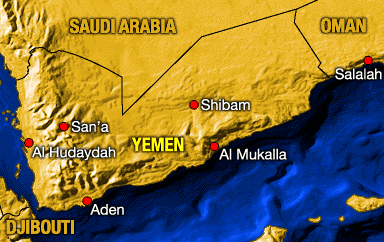
Washington knew for some time that Yemen was becoming a hotbed of Al-Qaeda terrorism. What it did not suspect was that a new battle front would have to be established there so soon. The situation was uncovered on Christmas, when a Nigerian, trained by the terrorist organization in the Arab country, was about to blow up an airplane in mid-flight, traveling from Europe to America. Since then, the name of the poorest nation in Asia, with 22 million inhabitants, has been resonating in the news. Several Western embassies closed their doors yesterday in Sanaa, the capital city, fearing terrorist attacks, and President Barack Obama has accelerated collaborative interaction with President Ali Abdullah Saleh to avert the new threat. Things, however, are not so simple, given the situation of Yemen, Al-Qaeda, Saleh’s government, and the United States in the area. With only a few thousand dollars of annual income per capita, the Yemeni territory hardly produces oil, sand and wars. The fall in oil prices has forced Yemen to seek help from their neighbors to survive, and its geographic conditions encourage the development of armed struggle.
Thus, their armies have fought battles against a rebellion in the north, a secessionist movement in the south, and terrorist cells that have established tribal and religious alliances on various parts of the map. The government chose to attend the first two fronts and forget the third, whose occasional attacks grew, thanks to a tacit pact with the regime. This permitted the arrival in Yemen of veterans of the wars in Afghanistan, terrorist commanders released from Guantanamo, fugitives who escaped from prison in 2006 with the complicity of some officials, and many young suicide “martyr” apprentices who arrived with more than 200,000 Somali refugees. These circumstances allowed the violent fundamentalists to grow from about 200 members to 2,000, becoming an important link for Al Qaeda in the Arabian Peninsula.
Meanwhile, Saleh’s government, corrupted by nepotism and lack of resources, has been able to do little, or been unwilling to do much, against the terrorist hypertrophy in its territory.
Twenty months ago, a secret visit by General David Petraeus, commander of the U.S. forces in the region, laid the groundwork to form Yemeni military units and provide them with adequate military equipment. Some results have already been seen.
On Monday, the Yemeni army took down two terrorists near the capital, but the gang leader escaped. In the next year and a half, Washington will allocate $170 million to the struggle. This leads to an additional situation: The U.S. is already fighting two wars in the region and, according to Secretary of State Hillary Clinton, will now face one more with “global repercussions.” This is no exaggeration; it can already be seen in the security of major airports and passenger restrictions from 14 countries, most of which are Arab.
Washington will not fight against Al-Qaeda directly, but through Saleh’s government. The difference with other battle fronts is important, as the same mistakes already made are not wanted to be committed again. It is a paradoxical situation for the Nobel Peace Prize winner, who asked for 30,000 new troops for Afghanistan and has no declared combating terrorists in Yemen a priority. Again, in the Middle East, the dynamic of events appears to exert greater force than President Obama’s desire for peace. This is the first chapter that bears his signature.

Leave a Reply
You must be logged in to post a comment.